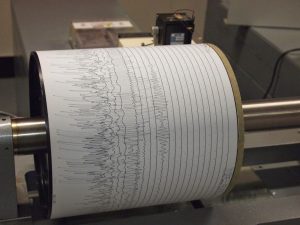
Accurate monitoring of the ground beneath our feet for signs of seismic activity to identify natural phenomena such as earthquakes, volcanic eruptions and the leakage of fluids stored deep underground remains challenging.
Time-lapse 4-dimensional seismic monitoring surveys that employ an active seismic source can accurately map the subsurface, and comparing results from different surveys can show how fluids (such as carbon dioxide, CO2) move in deep geological reservoirs. However, the expense of such surveys limits how often data can be gathered meaning that subsequent analysis often has poor temporal resolution. An alternative that provides a continuous dataset is the passive monitoring of ambient seismic noise, but the accuracy of this approach depends on the ambient sources, which can change over time.
In an article recently published in Geophysics, a team of researchers from Kyushu University and industrial and governmental representatives from Japan and Canada report a new method for accurately monitoring the shallow subsurface at a high spatiotemporal resolution. The method was developed using data from 2014 to 2016 that was collected from the Accurately Controlled Routinely Operated Signal System (ACROSS) located at the Aquistore CO2 storage site in Saskatchewan, Canada.
Obtaining a high-resolution characterization of the shallow subsurface has previously been held back by the limited number of ACROSS units, however the researchers were able to overcome this obstacle. As the lead author Tatsunori Ikeda explains: “applying spatially windowed surface-wave analysis allowed us to study the spatial variation of surface wave velocities using data from a single ACROSS unit.”
The research team validated their method against data gathered from hundreds of geophone measuring devices located around the ACROSS unit and a computational model of the site. Their analysis of the surface waves shows spatial variation in the surface wave velocities, and the impact of seasonal weather on these velocities. Confirmation of the method’s accuracy highlights its potential to identify changes in the shallow subsurface that may be caused by natural phenomena or fluids leaking from storage sites much deeper underground.
As well as drawing together experts from a variety of organizations in Japan and Canada, the publication represents another step forward for researchers in Kyushu University’s International Institute for Carbon-Neutral Energy Research (I2CNER). As co-author Takeshi Tsuji notes: “The approach contributes to our ongoing work in Kyushu University to develop a downsized, continuous and controlled seismic monitoring system.” The researchers have been operating the downsized monitoring system at the Kuju geothermal and volcanological research station on Japan’s Kyushu Island.
Reference:
Tatsunori Ikeda, Takeshi Tsuji, Masashi Nakatsukasa, Hideaki Ban, Ayato Kato, Kyle Worth, Don White, Brian Roberts. Imaging and monitoring of the shallow subsurface using spatially windowed surface-wave analysis with a single permanent seismic source. Geophysics, 2018; DOI: 10.1190/GEO2018-0084.1
Note: The above post is reprinted from materials provided by Kyushu University, I2CNER.










